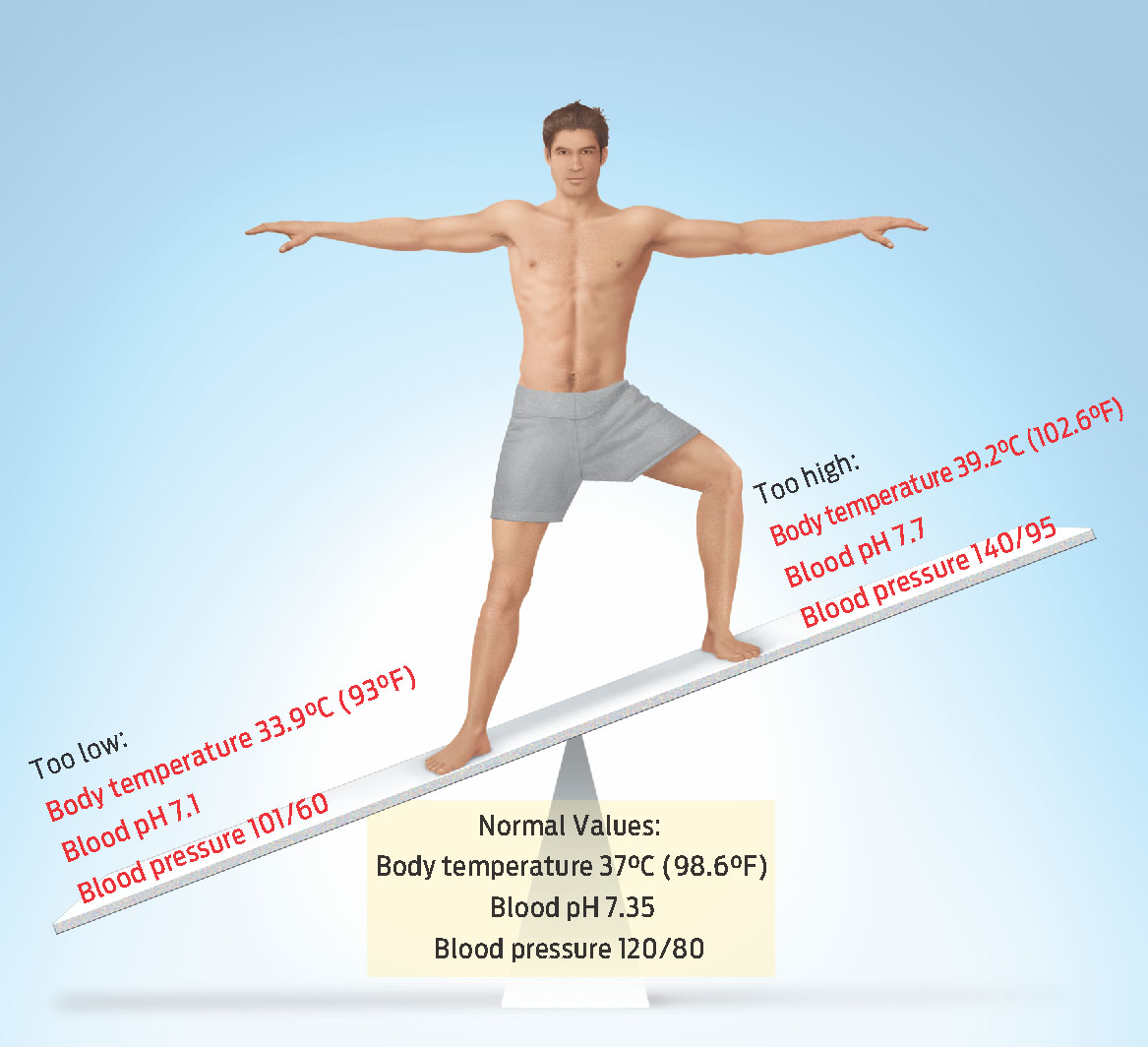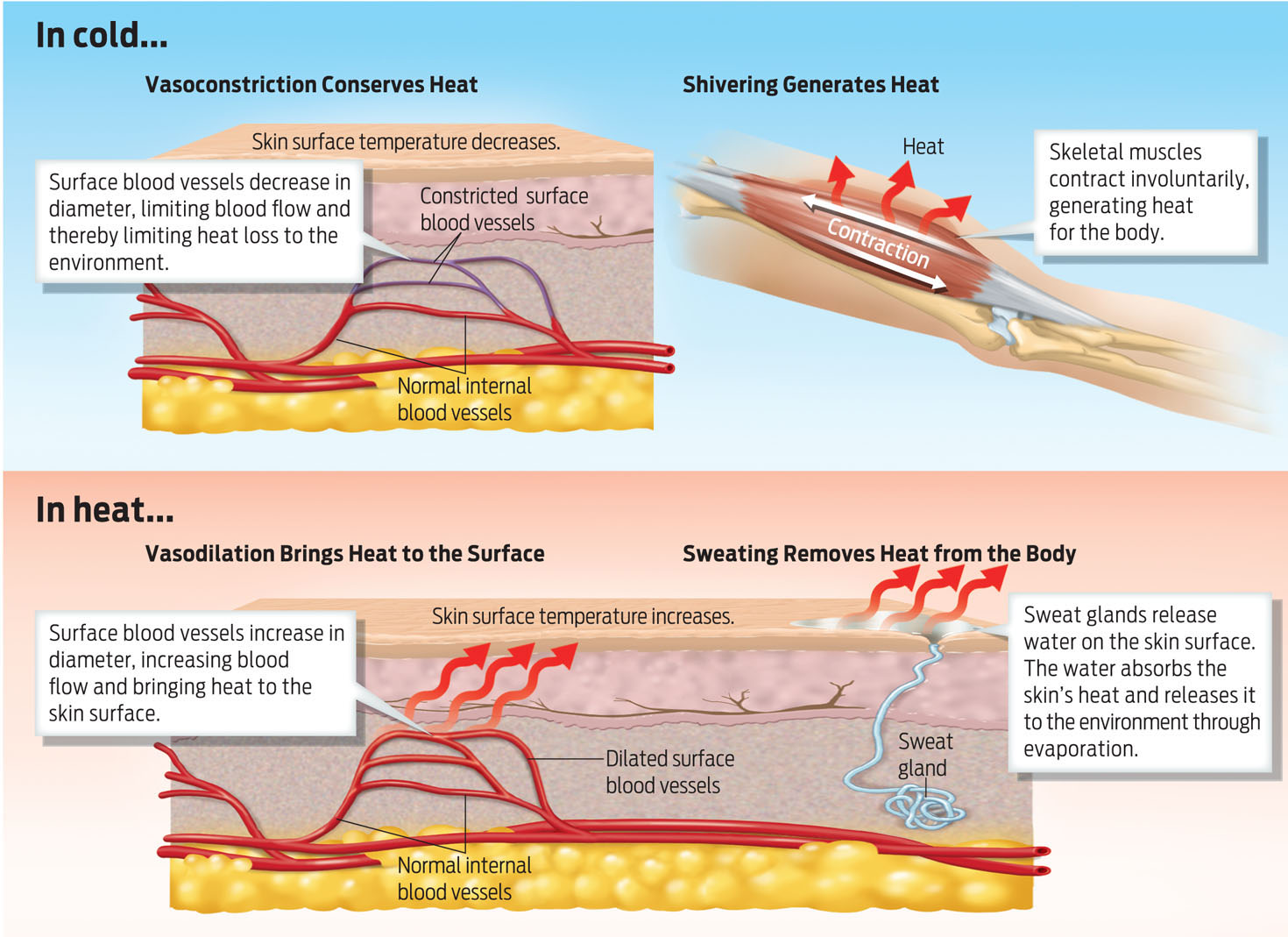THERMOREGULATION: THE PHYSIOLOGY OF STAYING WARM
THERMOREGULATION The maintenance of a relatively stable internal body temperature.
Like many other animals, humans have an optimal operating temperature and are exquisitely sensitive to temperature changes. Although we can tolerate a wide range of external temperatures in our daily lives, we cannot tolerate large fluctuations in our internal temperature. That’s because the enzymes that catalyze the chemical reactions in our body function only within a very narrow temperature range. The body works hard to maintain a relatively constant internal temperature compatible with life, fluctuating only about 0.5° C. Through this process of thermoregulation, our body temperature is kept at a consistent—and toasty—37°C (98.6°F).
Keeping a consistent body temperature is just one example of how the body tries to maintain homeostasis. “What we’re really thinking about with homeostasis are certain set points that your body needs to maintain,” explains Robert Kenefick, a research physiologist with the U.S. Army Research Institute of Environmental Medicine in Natick, Massachusetts. The body has a number of such set points, he says, for things like temperature, blood pH, and blood pressure, and it works hard to keep these factors balanced within a very narrow range, even in the face of a changing external environment. The consequences of not maintaining this balance can be deadly: a body temperature increase or decrease of just a few degrees, for example, can be lethal (INFOGRAPHIC 25.2).
The body expends a great deal of energy to maintain a constant internal environment. Only small fluctuations are tolerated, even in extreme external conditions.

VASOCONSTRICTION The reduction in diameter of blood vessels, which helps to retain heat.
As an exercise physiologist, Kenefick has spent his career trying to understand how the human body maintains homeostasis during strenuous activities like hiking and running marathons. He works in the Army Research Institute’s Thermal and Mountain Medicine Division, where a main focus of his research is understanding how the body performs in extreme cold.
Staying warm is hard to do when ambient temperatures drop below −50°C (−58°F), as they routinely do on Everest. To seal in heat, mountain climbers wear layers of protective gear designed to trap heat, wick away moisture, and insulate their bodies from the wind and cold. When not hiking, climbers consume copious amounts of hot tea or coffee to warm their insides. But insulated clothes and hot beverages would be of little help without the body’s natural way of keeping warm.
Human bodies respond to cold in two main ways: by conserving the heat they already have and by generating more. To conserve heat, the body performs what is called peripheral vasoconstriction—a decrease in the diameter of blood vessels just below the surface of the skin. By constricting blood vessels in the skin, peripheral vasoconstriction pushes blood from the skin to the body core, where the internal organs are.
“A lot of people believe this is done to increase the amount of blood that goes to your core to help protect those organs,” says Kenefick. There’s some truth in that, Kenefick notes, but a more important reason for peripheral vasoconstriction is, he explains, “to decrease the amount of heat loss from your skin to the environment.” Like most things in the universe, heat moves along a gradient from higher to lower. “If the temperature is higher in your skin and lower in the air, then you’re going to lose heat to the air. By bringing [these temperatures] closer together, you lose much less heat to the environment.” The clamping down of blood flow near the skin surface is why hands, feet, and noses are the first to feel cold on a cold day, and it’s a sign that your body is trying to retain heat.
VASODILATION The expansion in diameter of blood vessels, which helps to release heat.
The second way the body responds to cold is by trying to generate more heat. It does this by shivering, the involuntary contraction of normally voluntary muscles. “We know that the by-products of cellular respiration—any time cells work, and that includes your muscle cells—are CO2, heat, and water,” says Kenefick. “So when your muscles contract through shivering, they create heat, and that heat helps to warm up the core of your body.”
Of course, to maintain a constant temperature, our bodies must not only keep from getting too cold, they must also keep from getting too hot. Two main physiological responses help prevent overheating: peripheral vasodilation, the expansion of the diameter of blood vessels, which increases blood flow to the skin; and evaporative cooling, or sweating, which cools the body by releasing heat to the air.
In other words, you have a set point for body temperature: if you get too cold, you vasoconstrict and shiver; if you get too hot, you vasodilate and sweat. A precise balance between the two must be maintained to keep tissues healthy. If peripheral vasoconstriction goes on for too long, for example, the result is frostbite—the death of tissues caused by lack of blood flow (INFOGRAPHIC 25.3).
When the outside temperature is cold, the body works to maintain a constant internal temperature by conserving the heat it has and generating additional heat as well. When the outside temperature is hot, the body works to bring heat to the surface and release it into the environment.

Krakauer and his teammates were no strangers to the cold. After weeks of slowly ascending from camp to camp, they reached the launching pad for the summit, the South Col, at 1 P.M. On May 9. “It is one of the coldest, most inhospitable places I have ever been,” Krakauer wrote. A windswept saddle of rock and ice that sits between the peaks of Everest and neighboring Lhotse, the Col rests at 26,000 feet above sea level. Climbers pitch their tents on the relatively flat terrain and try not to think about the fact that they have entered what’s known as the death zone.
Conditions were particularly bad on the Col that day. Gale-force winds blew through the camp, limiting visibility. As Krakauer’s teammate, Beck Weathers, later recalled, “The weather was so crummy that when we first got in there, I didn’t think there was any chance that we were going to climb that night.”
But at 7 P.M., conditions improved markedly. It was still cold −26°C (−15°F)—but the wind had abruptly ceased, and by 11 P.M., above their heads, the stars appeared, while a gibbous moon reflected off the mountain snow. It was the perfect night for a climb.